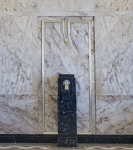Being new to the DC area and a new employee here at the Library of Congress, I have been very curious about the buildings, their architecture and history.
This building, built as an annex, was completed and opened to the public in 1939. It was initially named The Annex building. On June 13, 1980 it became known as the John Adams Building in honor of our second president who approved the law establishing the Library of Congress.
It is an interesting building with some unique features. When entering the building you are greeted by huge brass doors depicting the history of the written word in sculpted figures.
On the side of the building facing Independence Avenue you find a beautiful sculpted owl as you go up the steps. This entrance is no longer used, but it was originally intended for the Copyright Office. Currently you will find tables where one can stop and enjoy a bite, rest, or people watch.
sculpted owl as you go up the steps. This entrance is no longer used, but it was originally intended for the Copyright Office. Currently you will find tables where one can stop and enjoy a bite, rest, or people watch.
In the lobby area of the 5th floor, before you enter the reading room, there are two decorative pedestals (one at each end) that remind me of a scene from Indiana Jones.
 You’re on your way to the treasure and you have to pass through an area that could be dangerous, you must clear the obstacles before you enter the treasure room… the reading room!
You’re on your way to the treasure and you have to pass through an area that could be dangerous, you must clear the obstacles before you enter the treasure room… the reading room!
Some amazing photos have been taken of this building. You can find them in the Prints & Photographs Catalog with a subject search for Library of Congress Adams Building.
For more history of the buildings, doors, and architecture that makes up the Library of Congress, visit On These Walls.


November 3, 2009 at 7:10 pm
An interesting tidbit about the name of the Adams Building: For four years it was called the Thomas Jefferson Building!
As explained in _On These Walls_ (available on our Web site at http://www.loc.gov/loc/walls/adams.html:
“On April 13, 1976, in a ceremony at the Jefferson Memorial marking the birthday of Thomas Jefferson, President Ford signed into law the act to change the name of the Library of Congress Annex Building to the Library of Congress Thomas Jefferson Building. On June 13, 1980, the structure acquired its present name, which honors John Adams, the man of letters and president of the United States who in 1800 approved the law establishing the Library of Congress.”
November 4, 2009 at 12:32 pm
This is an interesting tidbit and I did miss including it. We plan to explore more of the history of the building and the relationship between Thomas Jefferson and John Adams in future posts. Thank you for the comment!
November 4, 2009 at 1:15 pm
Nice to see our proto art deco Adams bdlg finally getting some love.
“Beauty of style and harmony and grace and good rhythm depend on simplicity.” — Plato
November 19, 2009 at 3:58 pm
After reading about the building in Inside Adams, I was very excited to go and visit John Adams building of the LOC. I was not disappointed in seeing all the features mentioned in the blog, especially the South Reading Room with the Jefferson Murals. I wish the north Reading Room with Chaucers Murals is like the South Reading Room.
Also, I would like to suggest, scheduling events in Adams Building just like in Madison’s.
November 20, 2009 at 10:55 am
Events in the Adams Building would be nice but the building isn’t really equipped with the space to handle them. We do have a tour of the reading room that takes place on the first Wednesday of each month followed by a Business Reference Orientation for researchers.
We hope you come back and visit us again!
(correction made to day of the week on 12/8/09)
October 11, 2010 at 8:14 am
Of all the comments and definitions, etc., regarding yams and sweet potatoes, there is still no info about the origin of the “candied” yam or sweet potato!! Is there anyone who knows how the yam or sweet potato came to be “candied”?
Thanks.